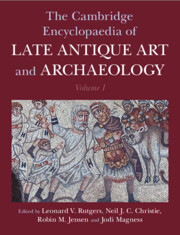Refine search
Actions for selected content:
5894 results in Classical art and architecture
7 - Jewish Architecture
- from Part I - Architecture and Iconography
-
- Book:
- The Cambridge Encyclopaedia of Late Antique Art and Archaeology
- Published online:
- 04 July 2025
- Print publication:
- 31 July 2025, pp 108-127
-
- Chapter
- Export citation
Contents
-
- Book:
- The Art of Queenship in the Hellenistic World
- Published online:
- 11 July 2025
- Print publication:
- 31 July 2025, pp vii-viii
-
- Chapter
- Export citation
38 - Countrysides of the Late Roman Western Empire
- from Part III - Urbanism and the Countryside
-
- Book:
- The Cambridge Encyclopaedia of Late Antique Art and Archaeology
- Published online:
- 04 July 2025
- Print publication:
- 31 July 2025, pp 657-680
-
- Chapter
- Export citation
Dedication
-
- Book:
- The Art of Queenship in the Hellenistic World
- Published online:
- 11 July 2025
- Print publication:
- 31 July 2025, pp v-vi
-
- Chapter
- Export citation
20 - Metalwork
- from Part II - Artefacts and Evidence
-
- Book:
- The Cambridge Encyclopaedia of Late Antique Art and Archaeology
- Published online:
- 04 July 2025
- Print publication:
- 31 July 2025, pp 374-397
-
- Chapter
- Export citation
31 - Antioch
- from Part III - Urbanism and the Countryside
-
- Book:
- The Cambridge Encyclopaedia of Late Antique Art and Archaeology
- Published online:
- 04 July 2025
- Print publication:
- 31 July 2025, pp 553-565
-
- Chapter
- Export citation
Frontmatter
-
- Book:
- The Cambridge Encyclopaedia of Late Antique Art and Archaeology
- Published online:
- 04 July 2025
- Print publication:
- 31 July 2025, pp i-iv
-
- Chapter
- Export citation
43 - Peoples of Eastern Europe
- from Part IV - Regional and Ethnic Variety
-
- Book:
- The Cambridge Encyclopaedia of Late Antique Art and Archaeology
- Published online:
- 04 July 2025
- Print publication:
- 31 July 2025, pp 759-776
-
- Chapter
- Export citation
Note on the Text
-
- Book:
- The Art of Queenship in the Hellenistic World
- Published online:
- 11 July 2025
- Print publication:
- 31 July 2025, pp xv-xvi
-
- Chapter
- Export citation
23 - Epigraphy
- from Part II - Artefacts and Evidence
-
- Book:
- The Cambridge Encyclopaedia of Late Antique Art and Archaeology
- Published online:
- 04 July 2025
- Print publication:
- 31 July 2025, pp 421-437
-
- Chapter
- Export citation

The Art of Queenship in the Hellenistic World
-
- Published online:
- 11 July 2025
- Print publication:
- 31 July 2025

The Cambridge Encyclopaedia of Late Antique Art and Archaeology
-
- Published online:
- 04 July 2025
- Print publication:
- 31 July 2025

The Cambridge Encyclopaedia of Late Antique Art and Archaeology
-
- Published online:
- 04 July 2025
- Print publication:
- 31 July 2025
Chapter 5 - Religion and Cult in the Sanctuary of Artemis
-
- Book:
- The Temple of Artemis at Sardis
- Published online:
- 30 May 2025
- Print publication:
- 03 July 2025, pp 175-198
-
- Chapter
- Export citation
Dedication
-
- Book:
- The Temple of Artemis at Sardis
- Published online:
- 30 May 2025
- Print publication:
- 03 July 2025, pp v-vi
-
- Chapter
- Export citation
Bibliography
-
- Book:
- The Temple of Artemis at Sardis
- Published online:
- 30 May 2025
- Print publication:
- 03 July 2025, pp 306-321
-
- Chapter
- Export citation
Chapter 7 - Architectural Analysis and Comparisons
-
- Book:
- The Temple of Artemis at Sardis
- Published online:
- 30 May 2025
- Print publication:
- 03 July 2025, pp 229-286
-
- Chapter
- Export citation
Plans
-
- Book:
- The Temple of Artemis at Sardis
- Published online:
- 30 May 2025
- Print publication:
- 03 July 2025, pp 287-292
-
- Chapter
- Export citation
Copyright page
-
- Book:
- The Temple of Artemis at Sardis
- Published online:
- 30 May 2025
- Print publication:
- 03 July 2025, pp iv-iv
-
- Chapter
- Export citation
Index
-
- Book:
- The Temple of Artemis at Sardis
- Published online:
- 30 May 2025
- Print publication:
- 03 July 2025, pp 322-324
-
- Chapter
- Export citation
